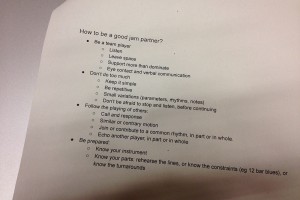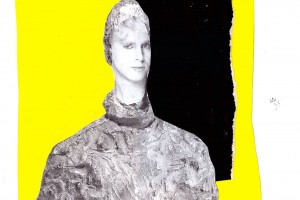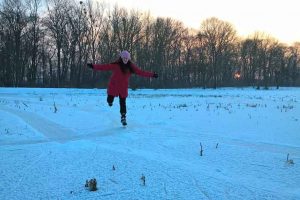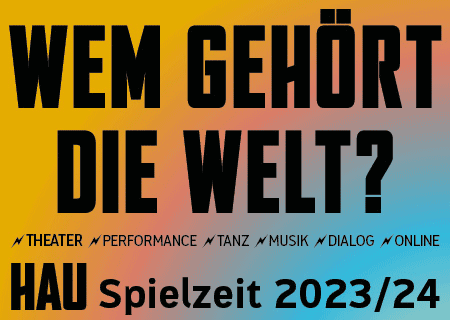Close to the people with a subtext
On September 9 and 10, the 8th edition of the Uckermark Festival will take place in Fergitz Pinnow in the Uckermark. Two of the curators, Ece Pazarbasi and Gudrun Gut, were so kind to answer kaput a few questions about the history of the festival and the programming of this year’s edition.
Gudrun, you are curating the Uckermark Festival together for the first time. How did you experience this process?
Gudrun Gut: The title of this year’s edition of the UM Festival, “CONNECT,” was found through joint conversations between Ece (who is responsible for art at the festival) and Ute Koenig (literature). There are always connections that work. In Ece’s case, it was because she was already working with Robert Lippok, whom I know well. Otherwise, she chose completely independently. I have a long history with Ute through the festival. We trust each other.
Otherwise, this time I focused more on the special requirements of this “family” festival, there are a lot of things to bring together.
The invitation of Veit Sprenger & Thies Mynther is on the initiative of me and Ute, they enchanted everyone last time with their Moon Machine – this time they will present new texts with music, performing different programs on the two days.
The pop newcomers will be represented by Post Neo and Baal & Mortimer – both acts are still young and relatively unknown – but great. Thomas Fehlmann brings the experience and elegance to the game. The connection to the old instrument accordion (through Annika Von Trier) will touch many Uckermärker:innen, just the sound of the instrument brings back memories. Elke Horner is a soloist from Brandenburg. The ensemble Quillo is also based in the Uckermark and stands for other approaches of new music, is universally popular and connects.
Yes, we want to: CONNECT!
Ece Pazarbasi: I had the distinct privilege of participating in this year’s Uckermark Festival, an opportunity extended to me through an invitation from Ilona Kalnoky, who holds the responsibility for the festival’s art section. Leading the curation of the art segment under the evocative title “Spooky Distance,” I developed a concept centered around quantum entanglement, exploring the profound correlation between two particles regardless of the physical expanse between them.
Upon sharing this concept with my fellow curators, a remarkable thematic synergy emerged. Gudrun ingeniously introduced the overarching theme of “CONNECT,” seamlessly weaving together a cohesive narrative that permeated the entirety of the festival. Furthermore, it goes without saying that the successful execution of each event hinged on meticulous collaboration—interweaving the spatial intricacies, logistical arrangements, and precise timing to craft a flawlessly orchestrated program.
Gudrun, you have been with the festival from the beginning, perhaps you could briefly explain the basic idea?
Gudrun Gut: The basic idea was to give something back to the Uckermark. The festival is organized by the association “Freunde der Uckermark eV”. These are people who have moved here and love the Uckermark. We wanted to pass on our experience in the cultural sector. We think that culture is an extension of life and can bring a lot of joy and food for thought. Since we come from different fields, we combined our competences:
For art, the visual artist Ilona Kalnoky and her husband Ferdinand von Hohenzollern were instrumental. Otherwise, Ute König and Andrea Ribbers (both from the literary scene) as well as Thomas Fehlmann, Dimitri Hegemann and I (all from the music scene) were part of the core team. At first we only invited friends, it slowly developed and became more professional. There are many volunteers and supporters who get involved.
From the outside, you could say that Berlin artists move to the countryside to organise a festival for the same people they have already played for in the big city. But of course that’s not the idea, it’s the explicit exchange with the regular local population. How well does that work?
Gudrun Gut: The people of the Uckermark have now become accustomed to the relatively large proportion of so called “Buletten” in the population. Many houses would have fallen into disrepair without them. Some gladly accept the festival, others are less interested. So as always – even in the city you can not force anyone. I think that the UM Festival is quite popular here. It brings life to the countryside and brings people together who might not otherwise have anything to do with each other. There’s food and drink and conversation.
Ece Pazarbasi: As a curator, my journey has encompassed the curation of exhibitions, festivals, and events within Turkey, also in the rural areas. Since 2018, I’ve undertaken a unique endeavor by establishing an experimental artist residency, Field Kitchen Academy, until now nestled in Wüsten Buchholz, near Perleberg. Although Wüsten Buchholz might not have witnessed an influx of urban migrations as pronounced as Uckermark, drawing from my firsthand experience, I can affirm that, akin to us Berliners, a substantial local community continues to thrive in this locale.
The crux lies in identifying the means to seamlessly integrate both these segments, thereby fostering genuine exchange. In this regard, I hold the belief that the UM Festival excels, exhibiting profound expertise in bridging diverse audiences and fostering numerous collaborations with local producers—thus fostering a robust economic dimension.To exemplify this synergy, the forthcoming edition of the festival’s art section will unveil an exquisite creation: a unique wine and schnapps collaboration stemming from the region. This collaboration brings together the talents of wine and schnapps producers and artists, culminating in the creation of limited-edition bottles. The convergence of artistic expression and regional craftsmanship yields a captivating and enjoyable endeavor—an embodiment of innovation and delight.
It was mentioned that various people who are known from the Berlin subculture of the 80s and 90s now live in the Uckermark (at least part of the time). How close is the local networking in general? Do people look for proximity? Or just not?
Gudrun Gut: Hmmm, I’m sometimes quite happy about an exchange, but not always. I also work a lot. But it’s nice to have friends in the neighborhood.
Back to this year’s programme. Is there something like a composition plan for the festival, like x electronic acts, y bands and z DJs should appear in the line-up? Or how do you imagine the stylistic programming? /strong>
Gudrun Gut: “CONNECT” is the keyword. Stylistically, it’s colorful. It has to be, because the audience is also colorful. I still have a fat list of acts that I would have liked to have been there. But you can’t have everything!
Ece Pazarbasi: For the arts section, every event is programmed with the theme of “Spooky Distance,” a term I coined by Einstein’s anti-quantum entanglement position. And the locations, the performances are very neatly arranged accordingly. Yet of course, we also followed to “CONNECT” to get connected to the theme, to the land, to the audience and to each other.
How important is it that there is not only music in the programming?
Gudrun Gut: That is essential. Music is only one part of the festival. It is clearly not a music festival. But I also don’t want music to be understood as a pure entertainment supplement to art or literature. All three areas stand for themselves and like to mix.
Ece Pazarbasi: In my viewpoint, my approach to curation consistently embraces interdisciplinarity. This approach not only fosters enriching exchanges but also paves the way for the creation of fresh neural pathways in our thought processes, thereby introducing novel facets into existence. Also I believe we are in an era that many artists are not interested in labeled as musicians, visual artists or performing artists – they are more interested in cross disciplinary stitches to broaden their and our perspective. Moreover, I hold the conviction that we inhabit an era where numerous artists eschew conventional labels such as musicians, visual artists, or performing artists. Instead, they gravitate towards interwoven disciplinary threads, thereby expanding not only their own horizons but also collectively broadening our vantage point.
Are there any derivations from the pandemic, so that the festival is now a different one than it was before the Covid years?
Ece Pazarbasi: The sense of distance and social separation during the Covid were among the reasons why I developed this concept for “Spooky Distance” – to raise the question of whether, even though we believed we were separate, perhaps we were not. But I cannot really say how it was int he recent years, what is your experience Gudrun?
Gudrun Gut: The last festival was called “UM Wege”. That was really great – music, art and literature everywhere. Short, varied and with a lot on the way. The connection to the last festival is, for example, the Ensemble Quillo (which I discovered back then) and Veit Sprenger & Thies Mynther.
What is the situation between the festivals, is there something like a year-round cultural mission that your association pursues in the region?
Gudrun Gut: We don’t have a cultural mandate. It is voluntary”
The festival takes place every two years and takes a lot of our energy. But we do panels and discussions and hikes in the years between the festivals.
Gudrun, when you look back over the past years, which performance has remained particularly memorable for you?
Gudrun Gut: Definitely Pilocka Krach on the big water tower stage in Gerswalde, or last time on the tractor. Then I played “Heimatlieder aus Deutschland” together with others – a wild trip around the world with seven musicians (including Wolfgang Voigt live with Polkatracks); especially with these acts the country connected wonderfully with the city – close to the people with subtext.
And: Ari Benjamin Mayer with his eight-hour performance of Satie’s “Vexations in Suckow” -–with simultaneous electronic processing by six musicians. Simply great. Or also Antye Greie Ripatti and her IPad Orchestra for young people; kids loved it.
Literature readings are always well received, too. I really like the listening stations: sitting under a tree listening to poetry.
And now the difficult question: Who are you looking forward to the most this year?
Ece Pazarbasi: This is indeed a very difficult question. Indeed the synergy that will be created among the all the works, concerts and literature pieces. Nevertheless, in the arts section, four of the artists were Field Kitchen Academy participants, which I am delighted to work with. The collaboration between Robert Lippok and Zeynep Ayse Hatipoglu is stemming on the very first edition of the Field Kitchen Academy where Robert was the working session facilitator and Ayse was a participant – so it will be a very exciting collaboration. Brad and Kyoco are coming up with very unusual, serene yet provoking pieces. Annika will take over the boat house and some body of water with a light installation for a feast for our day and night eyes. Andreas and Collective Mö, are have in a very subtle, yet prominent approach, that will lead and lead the audience to observe and prove further understanding and reading of nature. Viola Yip will also use the church attic in Fergitz for her intriguing performance.
Gudrun Gut: I am very much looking forward to Post Neo! and Baal & Mortimer as well as our young DJ’s Leonore and Phillipa. And of course the performance of Thomas Fehlmann. And the listening stations, the modular tower …
What do you suggest the kaput readers to listen to in preparation for the festival?
Ece Pazarbasi: They get a pretty good idea in the Field Kitchen Academy’s listening room.
Here, theywill be listening to a series of recordings that act as a catalogue and a log book of the Field Kitchen Academy. During the course of the residency each participant is assigned a particular day to make a 90 seconds of recording. The recordings had to be made on that exact given date, and reflect how they perceive that particular day at the residency from their own perspective.
UM Festival 2023 – „CONNECT“
ZEITGENÖSSISCHE KUNST, MUSIK UND LITERATUR
Fergitz · Pinnow | Uckermark
9. und 10. September 2023






















